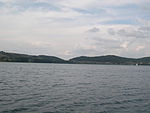Italian Air Force Museum
Aerospace museums in ItalyAir force museumsBraccianoItalian Air ForceMilitary and war museums in Italy ... and 2 more
Museums in LazioTransport museums in Italy

The Italian Air Force Museum is an aircraft museum at Vigna di Valle, on Lake Bracciano (Lazio), in central Italy. It is operated by the Aeronautica Militare. The museum's collection has an emphasis on Italian machines and seaplanes. While maintaining the technical and historical aspects, the museum is also dedicated to the influence aviation has had on Italian art, featuring works by Futurist painters Pietro Annigoni, Giacomo Balla, and Tato; and contemporary art such as Flight: Papiers froissés (literally crumpled paper) by Antonio Papasso.
Excerpt from the Wikipedia article Italian Air Force Museum (License: CC BY-SA 3.0, Authors, Images).Italian Air Force Museum
Via Circumlacuale,
Geographical coordinates (GPS) Address Website Nearby Places Show on map
Geographical coordinates (GPS)
| Latitude | Longitude |
|---|---|
| N 42.085049 ° | E 12.217108 ° |
Address
Aeroporto "Luigi Bourlot"
Via Circumlacuale 41
00062
Lazio, Italy
Open on Google Maps








